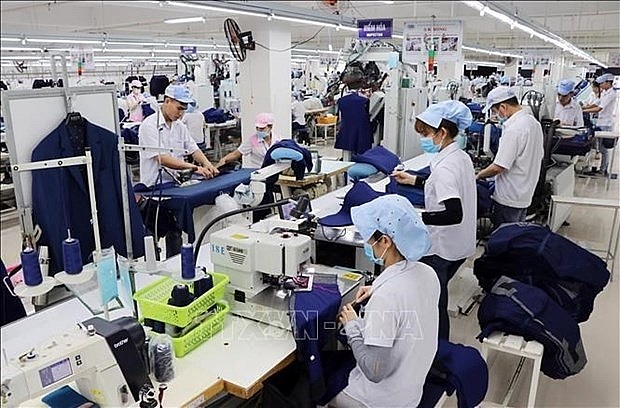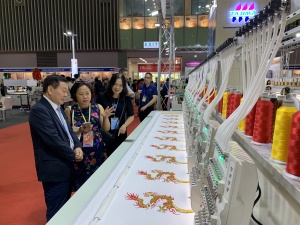Authorities request response to Chinese apparel rules
Earlier in October, the ministry (MoIT) requested organisations to conduct research and devise plans to implement China’s Order No.259. China is Vietnam’s second-greatest import market for apparel, after the US.
 |
| Authorities request response to Chinese apparel rules, photo VNA |
The northern neighbour’s customs department issued the order specifying procedures for inspection and acceptance of imported goods into the Chinese market, and followed it up with a notice, effective December 2022, on the application of Order 259’s regulations on textile and garment products.
The late response to the move in Vietnam has, according to some business leaders, caused extra challenges for apparel businesses that have been dealing with declining orders, rising production costs, and plummeting profits in 2023.
To comply with the requirements of Order 259, commodities inspection organisations on the territory of Vietnam must concurrently update new regulations and guide firms in the implementation of inspection procedures in order to receive a quality certificate for related exports.
Vu Duc Giang, president of the Vietnam Textile and Apparel Association, told VIR last week that the order was comparable to the EU’s Extended Producer Responsibility rules as well as the new Carbon Border Adjustment Mechanism.
“The third-party examination required for the textile and garment sector under Order 259 is a significant technical as well as quality hurdle for Vietnamese items imported into this market,” Giang said.
According to HQTS, a Chinese goods inspection organisation in District 3 of Ho Chi Minh City, there is an evaluation laboratory for products that fail to comply with import regulations regarding technical and quality standards.
China has roughly 44,000 firms that operate in garments and textiles production, according to the HQTS.
However, China’s actions could create a new dilemma for Vietnamese exporters, who are already contending with a decline in orders, higher costs of production, and a precipitous decline in profits.
Several exporters hesitate to rule out the potential for China to implement new foreign trade policy barriers to safeguard domestic production. By implementing Order 259, the country’s authorities appear to acknowledge difficulties in exporting textiles and apparel to the global market.
“China’s recent changes will benefit domestic textile and garment producers, but at the same time put greater strain on product lines supplied from Vietnam,” said a representative of one export firm.
According to the General Department of Vietnam Customs, textile and apparel exports to China are still falling, reaching only $7.5 billion in the first eight months of this year, a decrease of 11.6 per cent from the same period last year.
China is Vietnam’s largest import market for fibres, accounting for almost half of the total export value. In addition, the reopening of some of China’s net export items may have contributed to a reduction in the input costs of apparel companies, as almost 70 per cent of Vietnam’s fabric materials originate from China.
Global supply chains are growing more sustainable and balanced, while transit times are decreasing and getting closer to consumer demand.
Tran Quang Huy, director of the MoIT’s Market Trade Office for Africa, West Asia, and South Asia, said, “The Chinese economy has a plan and strives for high-quality development across most economic sectors. This indicates that China has set and continues to establish higher export and import product criteria.”
Huy demanded that Vietnamese firms alter to adapt. Currently, exports to China have favourable scale factors, but have not completely exploited the opportunity in China’s Western and Eastern regions, Huy added.
 | Domestic apparel firms encouraged to go greener Vietnamese textile and garment firms are being urged to green their production processes to keep up with the changes in export markets. |
What the stars mean:
★ Poor ★ ★ Promising ★★★ Good ★★★★ Very good ★★★★★ Exceptional
Related Contents
Latest News
More News
- Takeda supports health resilience amid climate change challenges (December 18, 2025 | 12:39)
- Mondelez Kinh Do - a chapter of purpose-led leadership in Vietnam (December 18, 2025 | 09:44)
- VNPAY services receive the highest-level PCI DSS international security certificates for six consecutive years (December 17, 2025 | 23:47)
- PPL extends its reach into ASEAN (December 17, 2025 | 15:44)
- Over 600 BUV graduates meeting quality benchmarks across triple quality assurance levels (December 17, 2025 | 13:00)
- HEINEKEN Vietnam partners with Ho Chi Minh City Traffic Police on road safety drive (December 17, 2025 | 09:42)
- BUV and China’s CSCSE sign MoU to boost educational cooperation (December 17, 2025 | 08:00)
- PVT Logistics honoured with ‘Fast Enterprise Award’ at APEA 2025 (December 16, 2025 | 18:22)
- Empowering Sustainable Data Centers with Smart Infrastructure Solutions (December 16, 2025 | 13:59)
- Vietjet wins gold ESG transport sustainability award in Taiwan (China) (December 13, 2025 | 22:03)

 Tag:
Tag:






















 Mobile Version
Mobile Version